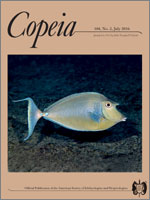External morphometrics were quantified and compared with body size for adults of an Oahu (Hawaii) population of the Bluespine Unicornfish (Naso unicornis). Specimens were obtained by monthly fishery-dependent collections during the period from April 2011 to July 2012. Three apparently size-related, sexually dimorphic traits were measured (cephalic horn length, to the nearest mm; several measures of peduncular keel/spine development, 0.1 mm; caudal fin filament length, mm) using dial calipers and related to fork length (FL, mm) for individuals of each sex. Histological slides of sub-adult and adult gonads were examined microscopically, and sexual identity and gonadal development and maturation were scored using standard criteria. Each of the metrics examined was sexually dimorphic and positively related to FL using simple linear regression. Logistic regression was used to evaluate the relative ability of each metric, or some combination thereof, to predict the sex of an individual fish. Although combinations of two or all three metrics accurately predicted sex, a single metric (peduncle width across the posterior keel) provided the most efficient and accurate (80% [75–84%, 95% CI] successful) predictor of an individual's sexual identity. Thus a single measure can be used to sex fish in the field. The implications of this finding relative to studies of the movement ecology and life history of this ecologically and economically important species are discussed.
BioOne.org will be down briefly for maintenance on 17 December 2024 between 18:00-22:00 Pacific Time US. We apologize for any inconvenience.
How to translate text using browser tools
14 June 2016
Sexual Dimorphisms in the Bluespine Unicornfish, Naso unicornis (Acanthuridae): External Metrics for Movement Ecology and Life History
Edward E. DeMartini
ACCESS THE FULL ARTICLE





